#Antiochus III
Explore tagged Tumblr posts
Text

Gold coin featuring Cleopatra I Syra
Cleopatra I Syra ("The Syrian") born around 204 BC. She was the daughter of Antiochus III the great and Laodice III. Cleopatra I married Ptolemy V of Egypt, solidifying an alliance between the Seleucid and Ptolemaic dynasties.
4 notes
·
View notes
Text
Honestly, I would like to see art of Hannibal Barca and Antiochus (III) the Great being best buds.
4 notes
·
View notes
Text
"Antiochos’ and Stratonike’s activities in the eastern part of the [Seleukid] empire are largely shrouded in mystery, but, as Engels has argued, Antiochos was far from idle since he embarked on a large building programme and was active in securing the frontier. There is some evidence to suggest that his new bride accompanied him for much of this period. We can perhaps identify Stratonike’s presence with her new husband in the Upper Satrapies through the gold coinage minted in Susa and Baktria in c . 287. The two gold coin sets are of the same type, the obverse features the laureate head of Apollo facing right and the reverse features Artemis in an elephant biga facing left with the legend ΒΑΣΙΛΕΩΣ ΣΕΛΕΥΚΟΥ in exergue.

Figure 1: Coin of Seleukos I from Baktria Depicting Apollo on the Obverse and Artemis with Elephant Biga on the Reverse (Houghton and Lorber 2002, SC I no. 163).

Figure 2: Coin of Seleukos I from Baktria Depicting Apollo on the Obverse and Artemis with Elephant Biga on the Reverse (Houghton and Lorber 2002, SC I no. 257).
The reverse image of Artemis in the elephant biga is within the same design type as a large range of other coinage issued by Seleukos I celebrating the success of his elephants and thus his eastern campaigns. The appearance of Artemis is however unique to these coin types. This suggests the emphasis on the close links between the twin gods, Artemis and Apollo, depicted on the obverse and reverse of this coinage . Since there appears to be as a close link between Apollo and Antiochos as there is between Zeus and Seleukos, the presence of Artemis could be seen as a symbol for Stratonike. This would create a series of parallels: Seleukos/Zeus, Antiochos/Apollo, and Stratonike/Artemis. The first two reflect what we see for these two kings at the list of priests of Seleukid kings in Seleukeia in Pieria . Additionally, it may be notable that the sister-wife ideology [...] appears to be evident later in the reign of Antiochos.
As all of the Apollo/Artemis cointypes were produced on high value gold coinage, this suggests that it was issued in order to commemorate a significant event. While the type was similar to other Seleukid coinage, the shift from Athena to Artemis was clearly discernible and unique. The arrival of the new joint-King and Queen in the region to take up residence would have been a suitable moment for the issuing of the new coin type. This advertisement of their new rule certainly falls in line with Seleukos’ wedding speech which confirmed their new roles."
-David Engels & Kyle Erickson, "Apama and Stratonike – Marriage and Legitimacy", "Seleukid Royal Women" (edited by Edited by Altay Coşkun and Alex McAuley). The pictures of the coins are screenshots from the book.
#historicwomendaily#stratonike#antiochus I soter#seleukid empire#hellenistic period#ancient history#history#'Antiochus’ and Stratonike’s activities in the eastern part of the empire are largely shrouded in mystery' don't do this to me#this mystery is mainly because of lack of accessibility or of evidence than lack of activity - but it's still a shame#also re the 'sister-wife ideology'#as historians have pointed out Stratonike was called 'hirtu' aka 'principal wife' in the famous Borsippa Cylinder of Antiochus I#an unusual title which indicates her precedence but also implies a polygamous situation (which was normal in the Hellenistic period)#centuries later Stephanos of Byzantion claimed that Antiochus named the city of Nysa 'after his wife Nysa'#Stephanos isn't really reliable: he's almost definitely wrong about the adjacent information he gives about the city of Antioch being named#after Antiochus's mother#but it may nonetheless indicate he had a minor wife named Nysa#epigraphic evidence also suggests Antiochus married a woman called 'sister-wife'#which many scholars have theorized was Nysa (as his half-sister)#though others believe the title was most likely honorific and shouldn't be taken literally#(for example Laodike - queen of Antiochos III - was also called sister-wife when we know she was actually his cousin)#so the epigraphical evidence may indicate a non-sibling Nysa or Stratonike#if it was a non-sibling Nysa then she may have also been a cousin or relative#but these coins of Antiochus and Stratonike as Apollo-and-Artemis clearly does play into the 'sister-wife ideology'#we know Antiochus strongly associated himself with Apollo and Stratonike made generous donations at Delos at Artemis-and-Apollo temples#so IF the title was honorific then it could have likely referred to Stratonike as well#also - we have no idea who Nysa was but if a city was named after her I wonder if her marriage was to boost local alliances?#which doesn't prelude the idea of her being a relative#we also don't know when they married - he married Stratonike in his late 20s so he may have even been married to her before that. who knows#anyway. the title of 'hirtu' being applied for Stratonike was VERY unique for the Seleukids...it's interesting to think about#(ik nobody but me cares about this but oh well)
9 notes
·
View notes
Photo
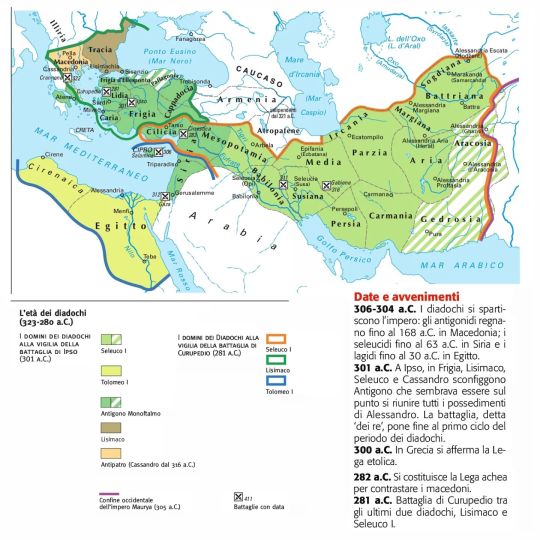
The Hellenistic world
"Atlante storico tascabile", Istituto Geografico De Agostini, Novara,1999
via cartesdhistoire
In 323 BC, Alexander died without heirs, possibly from the plague. His empire, already facing insurrectionary movements, did not outlive him. His generals, the Diadochi, began a protracted struggle for power: Antipater in Macedonia, Lysimachus in Thrace, Ptolemy in Egypt, Antigonus Monophthalmos in Asia Minor and Syria, and Seleucus in Babylon.
The first phase of the war among the Diadochi concluded at Ipsus in Phrygia in 301 BC, with the "battle of the kings." Lysimachus, Seleucus, and Cassander, son of Antipater, defeated Antigonus, who had been consistently victorious until then. Seleucus and Ptolemy, prudent rulers, founded dynasties destined for long endurance, even though they were not immune to the temptation of rebuilding Alexander's empire. The focal point of the conflict became Macedonia, and long wars ensued for its dominion.
The Epigones, successors of the Diadochi, instead supported the status quo. The kings of Egypt and Syria founded new cities, respecting the rights of existing poleis.
Nearly all Hellenistic kings surrounded themselves with scholars, artists, and scientists. Ptolemy I founded the largest library of antiquity in Alexandria, Egypt.
In 277 BC, the Galatians, of Celtic descent, settled in Asia Minor. Some provinces declared independence, including the kingdom of Pergamon, a city renowned for being built on terraces, distinguished by the splendor of its culture and art, exemplified by a library of 400,000 volumes.
The kingdom of Bactria, situated in the northern region of present-day Afghanistan, was also significant, representing the eastern extent of Hellenistic influence and serving as a crossroads between the cultures of the Mediterranean region and those of China and India.
Antiochus III, the greatest of the Seleucids, expanded the empire's territories. However, the invasion of Greece in 192 BC triggered a war with Rome. Following the war, the king was compelled to accept peace, marking the beginning of the inexorable decline of his empire.
86 notes
·
View notes
Text
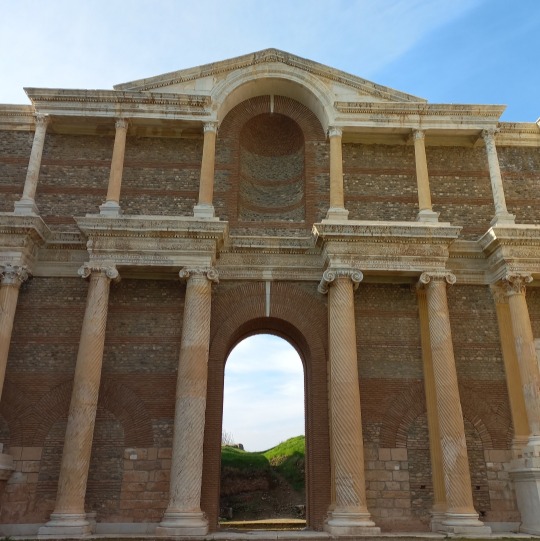
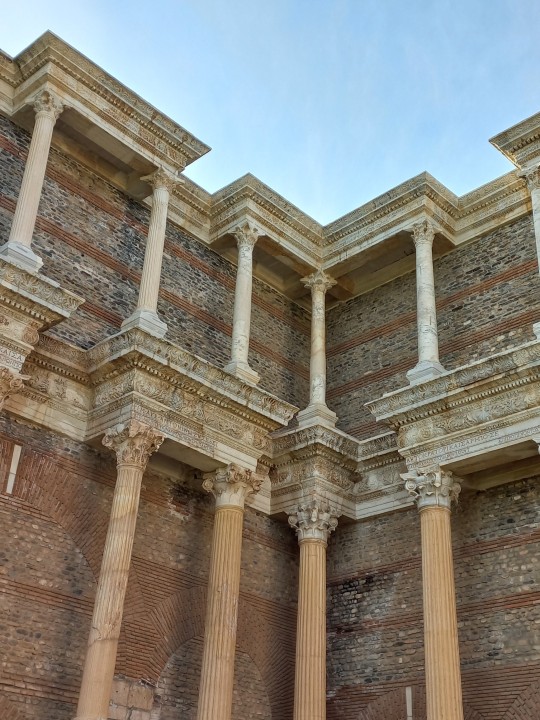
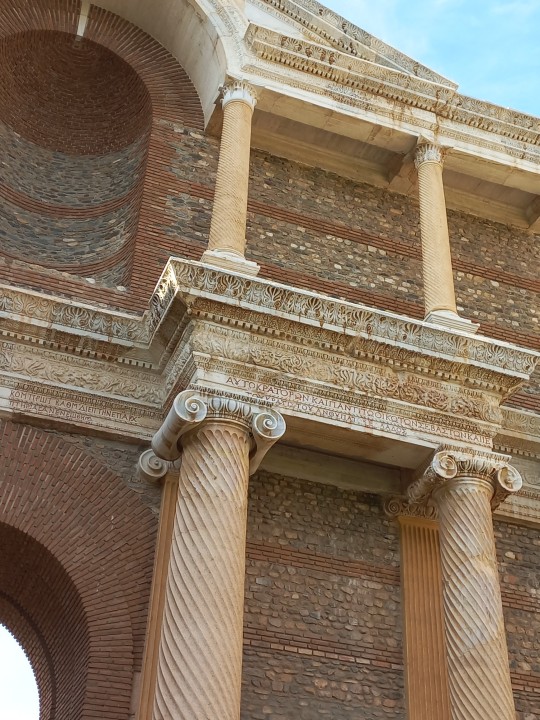
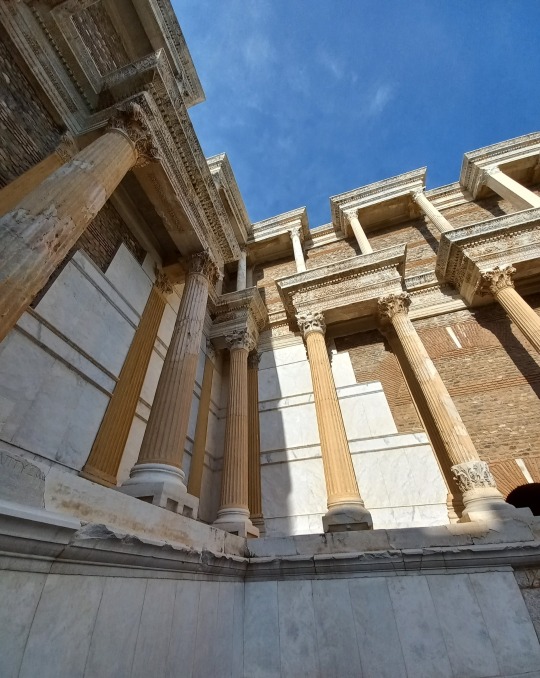
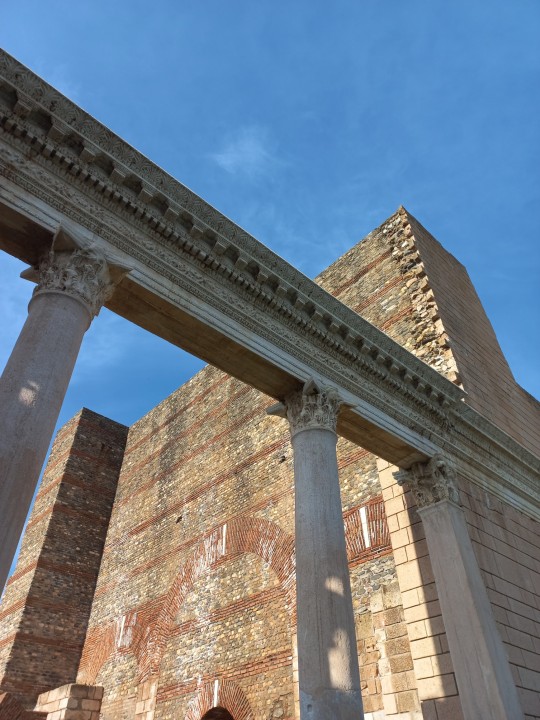
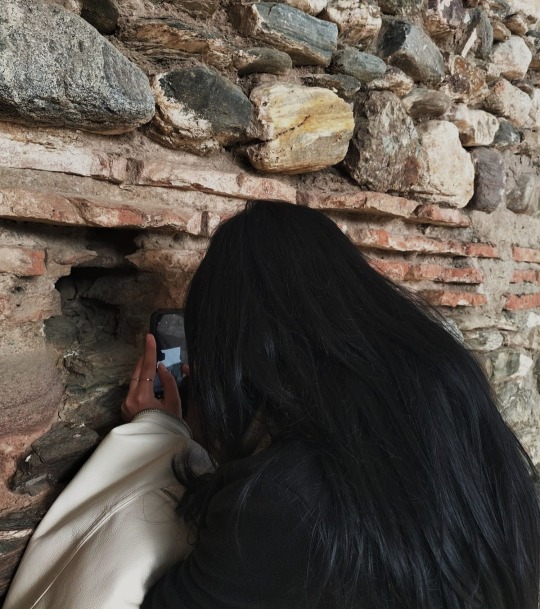

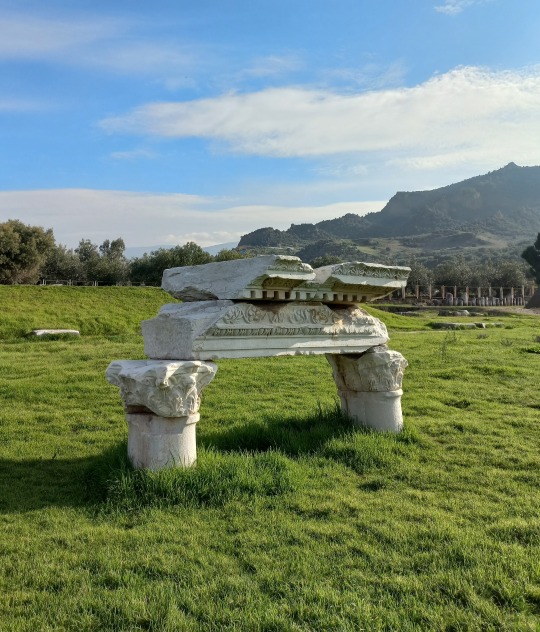
Sat, Jan 12 - I visited the ancient Roman city of Sardes today for the first time. (Information about the city is under this post.) It consisted of the Gymnasium with the remains of many Byzantine shops including restaurants and painting shops, a public pool, tombs, and a Synagogue. It was truly refreshing to see the place overall, but what I adored about the visit was the fact that you could imagine and experience the feeling of what it was like to be living in an ancient city, as it was empty because of the weather conditions. No voices, no noise, no motion, just the smell and the air of this ancient place. (I bet Henry Winter would die for it.) The Temple of Artemis was also close and I went there as well. I'll publish the pictures from the Synagogue and the Temple next if you want to check them out.
Sardis (/ˈsɑːrdɪs/ SAR-diss) or Sardes (/ˈsɑːrdiːs/SAR-de ess; Lydian: 𐤳𐤱𐤠𐤭𐤣, romanized: Sfard; Ancient Greek: Σάρδεις, romanized: Sárdeis; Old Persian: Sparda) was an ancient city best known as the capital of the Lydian Empire. After the fall of the Lydian Empire, it became the capital of the Persian satrapy of Lydia and later a major center of Hellenistic and Byzantine culture. It is now an active archaeological site in modern-day Turkey, in Manisa Province near Sart.
In 334 BC, Sardis was conquered by Alexander the Great. The city was surrendered without a fight, the local satrap having been killed during the Persian defeat at Granikos. After taking power, Alexander restored earlier Lydian customs and laws. For the next two centuries, the city passed between Hellenistic rulers including Antigonus Monophthalmos, Lysimachus, the Seleucids, and the Attalids. It was besieged by Seleucus I in 281 BC and by Antiochus III in 215-213 BC, but neither succeeded at breaching the acropolis, regarded as the strongest fortified place in the world. The city sometimes served as a royal residence, but was itself governed by an assembly.
In this era, the city took on a strong Greek character. The Greek language replaced the Lydian language in most inscriptions, and major buildings were constructed in Greek architectural styles to meet the needs of Greek cultural institutions. These new buildings included a prytaneion, gymnasium, theater, hippodrome, and the massive Temple of Artemis still visible to modern visitors. Jews were settled at Sardis by the Hellenistic king Antiochos III, where they built the Sardis Synagogue and formed a community that continued for much of Late Antiquity.
In 129 BC, Sardis passed to the Romans, under whom it continued its prosperity and political importance as part of the province of Asia. The city received three neocorate honors and was granted ten million sesterces as well as a temporary tax exemption to help it recover after a devastating earthquake in 17 AD.
Sardis had an early Christian community and is referred to in the New Testament as one of the seven churches of Asia. In the Book of Revelation, Jesus refers to Sardians as not finishing what they started, being about image rather than substance.
I take the pictures that are on my blog myself. In case you're interested in this post, I also post/reblog content including travel/cultural pictures, books, book recommendations, analysis, quotes, anything related to movies, series, and girl blog entries.
#sardes#ancient rome#ancient greek#gymnasium#ancient history#ancientmonuments#roman architecture#archeology#blog#travel#history#the secret history#henry winter#synagogue#dark academia#aesthetic#light academia#books#girlblogging#hellenistic#reading#if we were villains
40 notes
·
View notes
Note
Professor Reames, I was looking at the so called burial crown of Philip and I was wondering what’s the relation between that type of crown and the diadem?
None. They're two different things. First, "crowns" are typically made of plant stems woven together. Later, gold versions of this appear, like the crown in Royal Tomb II. (As you suggest with "so-called," that is probably not Philip's Tomb, whatever tags Greece or the media place on it. Why is a long, detailed story I don't have time to get into but there's literally years' worth of publishing about the identity of the bones in Royal Tombs I and II.)

These gold burial crowns are found ALL OVER the north/Balkan area by the Hellenistic period, but they show up before that (the ossuary of the Spartan general Brasidas at Amphipolis had one). This crown below is from the ginormous tomb of Seuthes III of Thrace, and looked to both Ann and I like a "I can do it bigger and better!" to the Macedonian vault tombs. It dates to the early Hellenistic period. The gold out of that tomb (found in the Kasanlak Museum) is impressive. But you'll see these things a lot. The one from Royal Tomb II is distinctive mostly by its size and attention to detail.

Crowns served lots of purposes. The four big atheletic Games in ancient Greece, including the Olympics and Pythian, were called "stephanic" because the only prize the winner got was a crown. (And not a gold one, either; it was either olive, laurel, pine, or wild celery, depending on the Contest.) It was the HONOR associated with the crown that mattered. (Stephanos = "crown" in Greek, if you or one of your friends is named "Stephen/Steven" or any variation.)
Anyway, crowns show up in all sorts of contexts from drinking parties (symposia) to burials--as with Tomb II. They don't imply anything royal, although they do usually imply some sort of honoring or "dressing up."
"Diadema" just means a headband. We see these all over, even before Alexander. It was designed to keep hair out of your face, often during sports, and might be made of leather or ribbon or some other flexible substance. The first image shows a guy tying one ... the ends are what he's holding in his hands. The pieces broke off the statue, so all that's left is what's around his head and what's in his hands. The second shows in marble the cloth back tie. Many statues had diadems attached in some other material that has since been lost. Remember, these statues were all painted and sometimes had "added bits" like semi-precious stones for eyes, or gold crowns, that later disappeared. So if you see an indention around the crown of a Greek (or Roman) statue? It's missing its diadem!


It was repurposed as women's jewelry too. See below. These start becoming prominent in the Hellenistic Era after ATG, but we do find them earlier, as noted. The diadem as a ROYAL symbol gets connected via Alexander, and then his Successors. (Coin of Antiochus below with his father Seleukos I's image in diadem.)


The diadem as ROYAL symbol seems to be specifically ancient near eastern. The Persian Great King employed it as sort of "action crown," different from the upright tiara that would fall off if he had to move around much (like fight). The Persian royal diadem was either white and blue striped or white and purple striped cloth, and was tied around the head so that the ends dangled.
Apparently, Alexander adopted it instead of the upright tiara (whether he really never wore the tiara is debated). Sometimes, he tied it around his hat (presumably the kausia, a special Macedonian hat that looked kinda like an ancient beret, but there doesn't seem much room on that for a band, so maybe a petasos, or floppy straw sunhat).
Anyway, the gold-covered silver circlet in Royal Tomb II at Vergina is a dressed up version, and one (of several) reasons people have argued it's not Philip's tomb. It's very unclear that the king used a diadem in Macedonia before Alexander. I'd argue they didn't, but admit we lack much evidence either way, except literary.

So while you wear both a crown and a diadem on the ol' noggin', these are two different objects. The later conflation of "crown" with "diadem" = a symbol of royalty, is medieval, or at most, late Roman.
#asks#diadema#Greek crown#Persian diadem#headbands in the ancient world#ancient women's jewelry#Successor artwork#Classics#ancient Greek dress#ancient Greece#ancient Macedonia#ancient Persia#Alexander the Great#Philip II of Macedon
15 notes
·
View notes
Photo

Polybius' Capture of Achaeus and Fall of Sardis
Polybius' Capture of Achaeus and Fall of Sardis is the account of the end of the Siege of Sardis (215-213 BCE) by Antiochus III (aka Antiochus the Great, r. 223-187 BCE) of the Seleucid Empire after the betrayal and capture of his cousin Achaeus (d. 213 BCE) who had proclaimed himself king.
The piece has become famous for the line describing Sardis as "the strongest place in the world" or "the strongest fortress in the world," almost always quoted out of context. Modern-day writers often repeat the line as though Polybius (l. c. 200 to c. 118 BCE) is claiming the city (and specifically the citadel) was "the strongest place in the world," but he is using that phrase ironically at the point in the story (8.20.12) when Achaeus has been captured while his people believe he is still safe in the citadel. The story is also well-known as a cautionary tale on trusting others, especially on matters of great importance.
Background & Summary of the Story
The Seleucid Empire (312-63 BCE) had been weakening since Arsaces I of Parthia (r. 247-217 BCE) had broken away to establish his own kingdom, encouraging others to do the same. Seleucid monarchs fumbled in trying to pull the empire back together until Antiochus III came to power in 223 BCE and, beginning in 219 BCE, personally led his troops on campaign to put down the revolts and reunite his territories. He entrusted Asia Minor, west of the Taurus Mountains, to his cousin Achaeus who had consistently proven his loyalty in the past. When Achaeus was accused of plotting insurrection, however, he understood that Antiochus III was not likely to wait to hear his side of the story or show mercy and so he declared himself King of Sardis and lord of the western territories. In 216 BCE, Antiochus arrived in Asia Minor (Anatolia) and placed Sardis under siege in 215 BCE.
The city was located in the Hermus Valley below the Mount Tmolus range, and high on the mountain was the acropolis with its famous citadel. Even if the city on the plain were taken, the citadel was easily defended and so, as the modern-day claim goes, may well have been regarded as "the strongest place in the world" (though Polybius does not use the phrase as many modern writers cite it). Achaeus, his wife Laodice of Pontus, his family and advisors, and others had all taken refuge in the citadel and there was no way for Antiochus to reach them. There was also, however, no way for Achaeus to leave and rally troops elsewhere to lift the siege.
Sosibius (l. 3rd century BCE), chief minister of Ptolemy Philopator of Egypt (r. 221-204 BCE), had been instrumental in the defeat of Antiochus III at the Battle of Raphia (also known as the Battle of Gaza, 217 BCE) which turned back the Seleucid king's invasion of Egypt. He now sought some means of freeing Achaeus from the citadel both to help the enemy of his enemy and, hopefully, defeat Antiochus III and break his power. Sosibius hired a Cretan named Bolis, who claimed to know the region around Sardis, could navigate the dangerous path down from the citadel at night, and would be able to lead Achaeus secretly to safety.
Once Bolis was hired and sent on his mission, however, he conferred with two others, Cambylus (an officer in Antiochus III's army) and Arianus (one of his own officers), and they agreed to divide the money Sosibius had given Bolis between them, inform Antiochus III of the plot and receive a sizeable reward from him, and then deliver Achaeus to Antiochus III for an even greater sum. The plan was put into effect, Achaeus was taken, handed over to Antiochus III, and executed, and Sardis fell in 213 BCE after the surrender of the citadel.
Continue reading...
14 notes
·
View notes
Text




The 8-day Jewish celebration known as #Hanukkah or #Chanukah begins today
The story:
2000 years ago the land of Israel was part of the Syrian-Greek Empire. Antiochus III, the King of Syria and his son Seleucus oppressed the Jews in the land of Israel.
That time, the Jewish Hellenists (Jews who accepted idol-worship and the Syrian-Greek way of life), while a tiny minority, have been amplified by the Greeks as they tokenized themselves against the Jewish people’s right to live as free people and as their own Jewish identity in the land of our ancestors (anti-Zionist Jews).
One day the henchmen of Antiochus arrived in the village of Modiin where Mattityahu, the old priest, lived. He built an altar and demanded that Mattityahu offer sacrifices to the Greek gods. Mattityahu refused.
One Hellenistic Jew approached the altar to offer a sacrifice, but Mattityahu stopped him and destroyed the altar.
Mattityahu knew that Antiochus would be enraged so he fled together with his sons and friends to the hills of Judea.
Many courageous Jews joined them and formed a rebellion. Before his death, Mattityahu called his sons together and urged them to continue to fight. In waging warfare, he said, their leader should be Judah the Strong. Judah was called "Maccabee," a word composed of the initial letters of the four Hebrew words מי כמכה באלים ה׳, "Who is like You, O God.”
Later, Antiochus sent his General Apolonius to wipe out Judah and his followers, the Maccabees. An army consisting of more than 40,000 men swept the land.
When Judah the Maccabee heard it, he said: "Let us fight unto death in defense of our souls and our Temple!"
The war was won and the Maccabees returned to Jerusalem, entered the Temple and cleared it of the idols placed by the Syrian vandals.
Since the golden Menorah had been stolen by the Syrians, the Maccabees now made one of cheaper metal.
There was only a small cruse of pure olive oil, which was sufficient to light only for one day. Yet, it continued to burn for 8 days. In the memory of the miracle, our sages appointed these eight days for annual thanksgiving and for lighting candles
Hen Mazzig
200 notes
·
View notes
Text

Antiochus III the Great
4 notes
·
View notes
Text
This insistence that there were no unspeakable mysteries or any feasting in the Temple is to be connected with the statements that when Antiochus (Epiphanes) ravaged the Temple he did not find anything there that was ridiculous, although what was found cannot berevealed to other nations (Wars V 5.5). Josephus' curious vacillation between the assertion that there was nothing at all in the Holy of Holies, and the admission that there was something there, but nothing ridiculous, and that what was there could not be revealed, Patai plausibly related to the figures of the two Cherubim and the embarrassment occasioned by their representation in sexual embrace. The representation of the Cherubim in sexual embrace is attested in Talmudic tradition by Rab Qetina who flourished in the late third or early fourth century: When Israel used to make the pilgrimage, they (the priests) would roll up for them the paroket (the curtain between the Holy and the Holy of Holies in the Second Temple) and show them the Cherubim which were entwined with one another, and say to them: "Behold! your love before God is like the love of male and female" (TB Yoma 54a).
[...]
There is a Talmudic tradition that the Cherubim, although they were golden statues, had mobility: "As long as Israel fulfilled the will of God, the faces of the Cherubim were turned toward each other; however, when Israel sinned, they turned their faces away from each other." (TB Baba Bathra 99a). Whether the Cherubim spent more time vis a vis or dos a dos, their ideal and properposition was face to face. The sexual embrace of the Cherubim is confirmed by the testimony of the distinguished Palestinian sage Rabbi Simeon ben Laqish (ca. 200-275) with reference to the sacking of the Temple: When strangers entered the Sanctuary, they saw the Cherubim intertwined with each other; they took them out into the marketplace and said: "Israel, whose blessing is a blessing and whose curse a curse, should occupy themselves with such things! And they despised them, as it is written, 'All who honored her despise her, because they have seen her nakedness' (Lam 1:8; TB Yoma 54b). This same tradition, that the heathen saw the Cherubim in sexual embrace and ridiculed the Jews for their hypocrisy, is preserved in other Midrashim: When (Israel's) sins caused the Gentiles to enter Jerusalem, Ammonites and Moabites came together with them, and they entered the House of the Holy of Holies, and they found there the two Cherubim, and they took them and put them in a cage and went around with them in all the streets of Jerusalem and said: "You used to say that this nation was not serving idols. Now see what we found and what they were worshiping." (Cf. Patai, 305-308, for references and an extended discussion of the historical setting of this incident.)
[...]
Maimonides (d.1204), e.g., explained that the two angels over the ark (i.e. the Cherubim) were made to consolidate the popular belief in the existence of angels and to refute idolatry. If there had been one image, this might have been misleading, since it might have been thought that that was the image of the deity who was to be worshiped, as done by idolaters. Since there were two Cherubim and the explicit statement that "the Lord is One," the validity of the belief inthe existence of angels and the fact that they are many is confirmed, and the error that they are the deity confuted—the deity being one and having created the multiplicity (cf. Maimonides, Guide to the Perplexed iii 45. Translated from the Arabic by S. Pines, 1963, 577). Mystics, on the other hand, seized on the embrace of the Cherubim for the reinforcement of the basic doctrine of the sanctity of sex and the cosmic necessity of sexual intercourse between man and wife. The Qabbalah found in the clasping Cherubim basis for two of its central doctrines, that union of male and female is the prime state of blessedness and that when man sins he causes a separation in the male and female aspects of deity which in turn leads to transcendental and universal disaster.
155-157, Song of Songs (commentary) by Marvin Pope
3 notes
·
View notes
Text
I didn't expect Hannibal Barca and Antiochus (III) the Great would know each other and Hannibal would be a military advisor to Antiochus the Great when first learning about this.
@scribl1ta
1 note
·
View note
Text
One of my increasingly favorite pastimes is imagining Shakespeare as an actor performing roles in his own plays, so without further ado, here are the roles we think Shakespeare he performed (per stylistic analysis and contemporary accounts):
The Lord (Induction) (Taming of the Shrew)
Antonio, the Duke (Two Gentlemen of Verona)
Suffolk (Henry VI Part 2)
Warwick, Old Clifford (Henry VI Part 3)
Mortimer or Exeter (Henry VI Part 1)
Aaron (Titus Andronicus)
Clarence, Scrivener, and Third Citizen (Richard III)
Egeon (Comedy of Errors)
Friar Lawrence and Chorus (Romeo and Juliet)
Duke Theseus (A Midsummer Night’s Dream)
Old Gaunt and/or the Gardener, the Lord (Richard II)
Leonato, the Friar (Much Ado About Nothing)
King Henry, Rumor (Henry IV Parts I & II)
The Garter Inn’s Host, Master Ford (The Merry Wives of Windsor)
Old Kno’well (Every Man In His Humor by Ben Jonson)
Chorus, Ely, and Mountjoy (Henry V)
Adam, later Corin (As You Like It)
Flavius (Julius Caesar)
Ghost, First Player (Hamlet)
Antonio (Twelfth Night)
Ulysses (Troilus and Cressida)
Macro and Sabinus (Sejanus His Fall by Ben Jonson)
Brabantio (Othello)
The King (All’s Well that Ends Well)
The Poet (Timon of Athens)
Duncan, perhaps Banquo later on (Macbeth)
Antiochus and Simonides, Cleon (Pericles)
#william shakespeare#shakespeare#i’m haunted by his aaron the moor#even his leonato…#he was said to perform old man/father/kingly roles#i also think he played lodovico in othello#also added the ben jonson ones because why not#oh and clarence!!!
19 notes
·
View notes
Text
Holidays 12.13
Holidays
Acadian Remembrance Day (Canada)
Anesthesia Technicians Day (Turkey)
Bicycle Built For Two Day
Blame Someone Else Day
Clip-On Tie Day
Count the "La's" in "Deck the Halls" Day
Ella Josephine Baker Day
International ACAB Day
Jane Addams Day
Jum ir-Repubblika (Malta)
Loki Day
Martial Law Victims Remembrance Day (Poland)
Nanking Massacre Memorial Day (China)
National Bring Your Brother-in-Law to Work Day
National Day (Saint Lucia)
National Day of the Horse [also 2nd Saturday]
National Guard Day (US)
National Violin Day
New Calendar Day
Nusantara Day (Indonesia)
Peace Day (Korea)
Pick a Pathologist Pal Day
Reed Plant Dat (French Republic)
Republic Day (Malta)
Sailor’s Day (Brazil)
Santa Lucia Day (Sweden, Scandinavia)
Skip Day
Swiftie Day
Unreturned Library Book Day
World Violins Day
Yuletide Lad #2 arrives (Giljagaur or Gully Oaf; Iceland)
Food & Drink Celebrations
Ice Cream and Violins Day
National Cocoa Day
National Cream Cheese Frosting Day
National Ice Cream Day
National Popcorn String Day
World Raclette Day
2nd Wednesday in December
Book Club Day [2nd Wednesday]
Independence Days
Vendsyssel (Declared; 2018) [unrecognized]
Feast Days
Antiochus of Sulcis (Christian; Saint)
Aubert (Christian; Saint)
Comp-U-Coffee 2000 (Muppetism)
Emily Carr (Artology)
Euler (Positivist; Saint)
Feast of the Light-Bringer (Old Swedish Goddess of Light)
Hanukkah Day #6 (Judaism) [thru Dec. 15th]
Herman of Alaska (American Orthodox Church)
Ides of December (Ancient Rome)
John Marinoni (Christian; Blessed)
John Wayne Day (Church of the SubGenius; Saint)
Judoc (a.k.a. Joyce; Christian; Saint)
Kenelm, King (Christian; Saint)
Larry Storch Day (Church of the SubGenius; Saint)
Losar (Ladakh, India)
Losoong (a.k.a. Namsoong; Sikkim, India)
Luciadagen (a.k.a. Little Yule; Scandinavia)
Lucia’s Day (Pagan)
Lucy (Christian; Saint) [Writers]
Monkey Appreciation Day (Pastafarian)
Odile of Alsace (Christian; Saint)
Othilia (Christian; Saint)
The Sementivaem (Ancient Rome)
Tellus (Ancient Rome, with table spread for Ceres)
Thorn Cutting Ceremony Day (Glastonbury, England; Celtic)
Lucky & Unlucky Days
Martes (Unlucky Tuesday; Spanish culture) [Tuesday the 13th] (2 of 2 for 2022)
Prime Number Day: 347 [69 of 72]
Taian (大安 Japan) [Lucky all day.]
Triti (Unlucky Day; Greece) [Tuesday the 13th] (2 of 2 for 2022)
Premieres
Agents of S.H.I.E.L.D.: Slingshot (Web Series; 2016)
American Hustle (Film; 2013)
An American in Paris, by George Gershwin (Broadway Musical; 1928)
Bedknobs and Broomsticks (Disney Film; 1971)
Beyoncé, by Beyoncé (Album; 2013)
Bugsy (Film; 1991)
A Chorus Line (Film; 1985)
Clue (Film; 1985)
Dark Star, performed by the Grateful Dead (Song; 1967)
Driving Miss Daisy (Film; 1989)
Emily of New Moon, by L.M. Montgomery (Novel; 1923)
Fool Coverage (WB LT Cartoon; 1952)
Foxy Lady, recorded by Jimi Hendrix (Song; 1966)
The Getaway (Film; 1972)
The Hobbit: The Desolation of Smaug (Film; 2013) [3 of 3]
Jerry Maguire (Film; 1996)
The Jewel of the Nile (Film; 1985)
Jumanji: The Next Level (Film; 2019)
The Lord of the Rings: The War of the Rohirrim (Animated Film; 2024)
Maid in Manhattan (Film; 2002)
Mars Attacks! (Film; 1996)
A Miser Brothers’ Christmas (Animated TV Special; 2008)
Monitored Noose or The Carbon Copy-Cats (Rocky & Bullwinkle Cartoon, S1, Ep. 6; 1959)
My Name is Nobody (Film; 1973)
The Poseidon Adventure (Film; 1972)
Rakuen Tsuiho: Expelled from Paradise (Anime Film; 2014)
Richard III (Film; 1955)
Saving Mr. Banks (Film; 2013)
Scooby-Doo! Pirates ahoy! (WB Animated Film; 2005)
The Scorched Moose (Rocky & Bullwinkle Cartoon, S1, Ep. 5; 1959)
Sense and Sensibility (Film; 1996)
6 Underground (Film; 2019)
Star Trek: Nemesis (Film; 2002)
Tristessa, by Jack Kerouac (Novel; 1960)
Uncut Gems (Film; 2019)
Wind (Pixar Cartoon; 2019)
Today’s Name Days
Jodok, Lucia, Odilia (Austria)
Jasna, Lucija, Otilija, Svjetlana (Croatia)
Lucie (Czech Republic)
Lucia (Denmark)
Ele, Ere, Hele, Loviise, Lucia, Luise, Viise (Estonia)
Seija (Finland)
Jocelyn, Lucie (France)
Jodok, Johanna, Lucia, Ottilia (Germany)
Aris, Efstratios, Ioubenalios, Evstratios, Loukia, Lucy, Stratos (Greece)
Luca, Otilia (Hungary)
Antioco, Lucia (Italy)
Lūcija, Veldze (Latvia)
Eiviltė, Kastautas, Kastytis, Liucija, Otilija (Lithuania)
Lucia, Lydia (Norway)
Łucja, Lucja, Otylia, Włodzisława (Poland)
Dosoftei (Romania)
Lucia (Slovakia)
Lucía, Otilia (Spain)
Lucia (Sweden)
Louise, Lucia, Lukia (Ukraine)
Cinderella, Cindy, Cynth, Cynthia (USA)
Today is Also…
Day of Year: Day 347 of 2024; 18 days remaining in the year
ISO: Day 3 of week 50 of 2023
Celtic Tree Calendar: Ruis (Elder) [Day 16 of 28]
Chinese: Month 12 (Jia-Zi), Day 1 (Yi-Si)
Chinese Year of the: Rabbit 4721 (until February 10, 2024)
Hebrew: 1 Teveth 5784
Islamic: 30 Jumada I 1445
J Cal: 17 Zima; Threesday [17 of 30]
Julian: 30 November 2023
Moon: 1%: Waxing Crescent
Positivist: 11 Bichat (13th Month) [Euler]
Runic Half Month: Jara (Year) [Day 3 of 15]
Season: Autumn (Day 81 of 89)
Zodiac: Sagittarius (Day 22 of 30)
Calendar Changes
冰月 [Bīngyuè] (Chinese Lunisolar Calendar) [Month 12 of 12] (Ice Month) [Earthly Branch: Ox Month] (End-of-Year Month)
Ṭēḇēṯ (a.k.a. Tevet, Tebeth & Tebetu) [טֵבֵת] (Hebrew Calendar) [Month 10 of 12]
2 notes
·
View notes
Text
Events 6.22
217 BC – Battle of Raphia: Ptolemy IV Philopator of Egypt defeats Antiochus III the Great of the Seleucid kingdom. 168 BC – Battle of Pydna: Romans under Lucius Aemilius Paullus defeat Macedonian King Perseus who surrenders after the battle, ending the Third Macedonian War. 813 – Battle of Versinikia: The Bulgars led by Krum defeat the Byzantine army near Edirne. Emperor Michael I is forced to abdicate in favor of Leo V the Armenian. 910 – The Hungarians defeat the East Frankish army near the Rednitz River, killing its leader Gebhard, Duke of Lotharingia (Lorraine). 1527 – Fatahillah expels Portuguese forces from Sunda Kelapa, now regarded as the foundation of Jakarta. 1593 – Battle of Sisak: Allied Christian troops defeat the Ottomans. 1633 – The Holy Office in Rome forces Galileo Galilei to recant his view that the Sun, not the Earth, is the center of the Universe in the form he presented it in, after heated controversy. 1774 – The British pass the Quebec Act, setting out rules of governance for the colony of Quebec in British North America. 1783 – A poisonous cloud caused by the eruption of the Laki volcano in Iceland reaches Le Havre in France. 1807 – In the Chesapeake–Leopard affair, the British warship HMS Leopard attacks and boards the American frigate USS Chesapeake. 1813 – War of 1812: After learning of American plans for a surprise attack on Beaver Dams in Ontario, Laura Secord sets out on a thirty kilometres (19 mi) journey on foot to warn Lieutenant James FitzGibbon. 1839 – Cherokee leaders Major Ridge, John Ridge, and Elias Boudinot are assassinated for signing the Treaty of New Echota, which had resulted in the Trail of Tears. 1870 – The United States Department of Justice is created by the U.S. Congress. 1893 – The Royal Navy battleship HMS Camperdown accidentally rams the British Mediterranean Fleet flagship HMS Victoria which sinks taking 358 crew with her, including the fleet's commander, Vice-Admiral Sir George Tryon. 1897 – British colonial officers Charles Walter Rand and Lt. Charles Egerton Ayerst are assassinated in Pune, Maharashtra, India by the Chapekar brothers and Mahadeo Vinayak Ranade, who are later caught and hanged. 1898 – Spanish–American War: In a chaotic operation, 6,000 men of the U.S. Fifth Army Corps begins landing at Daiquirí, Cuba, about 16 miles (26 km) east of Santiago de Cuba. Lt. Gen. Arsenio Linares y Pombo of the Spanish Army outnumbers them two-to-one, but does not oppose the landings. 1907 – The London Underground's Charing Cross, Euston and Hampstead Railway opens. 1911 – George V and Mary of Teck are crowned King and Queen of the United Kingdom of Great Britain and Ireland. 1911 – Mexican Revolution: Government forces bring an end to the Magonista rebellion of 1911 in the Second Battle of Tijuana. 1918 – The Hammond Circus Train Wreck kills 86 and injures 127 near Hammond, Indiana. 1940 – World War II: France is forced to sign the Second Compiègne armistice with Germany, in the same railroad car in which the Germans signed the Armistice in 1918. 1941 – World War II: Nazi Germany invades the Soviet Union in Operation Barbarossa. 1942 – World War II: Erwin Rommel is promoted to Field Marshal after the Axis capture of Tobruk. 1942 – The Pledge of Allegiance is formally adopted by US Congress. 1944 – World War II: Opening day of the Soviet Union's Operation Bagration against the Army Group Centre. 1944 – U.S. President Franklin D. Roosevelt signs into law the Servicemen's Readjustment Act of 1944, commonly known as the G.I. Bill. 1945 – World War II: The Battle of Okinawa comes to an end. 1948 – The ship HMT Empire Windrush brought the first group of 802 West Indian immigrants to Tilbury, marking the start of modern immigration to the United Kingdom. 1948 – King George VI formally gives up the title "Emperor of India", half a year after Britain actually gave up its rule of India. 1962 – Air France Flight 117 crashes on approach to Pointe-à-Pitre International Airport in Guadeloupe, killing 112 people. 1965 – The Treaty on Basic Relations between Japan and the Republic of Korea is signed. 1966 – Vietnamese Buddhist activist leader Thích Trí Quang was arrested as the military junta of Nguyen Cao Ky crushed the Buddhist Uprising. 1969 – The Cuyahoga River catches fire in Cleveland, Ohio, drawing national attention to water pollution, and spurring the passing of the Clean Water Act and the creation of the Environmental Protection Agency. 1978 – Charon, the first of Pluto's satellites to be discovered, was first seen at the United States Naval Observatory by James W. Christy. 1979 – Former Liberal Party leader Jeremy Thorpe was acquitted of conspiracy to murder Norman Scott, who had accused Thorpe of having a relationship with him. 1984 – Virgin Atlantic launches with its first flight from London to Newark. 1986 – The famous Hand of God goal, scored by Diego Maradona in the quarter-finals of the 1986 FIFA World Cup match between Argentina and England, ignites controversy. This was later followed by the Goal of the Century. Argentina wins 2–1 and later goes on to win the World Cup. 1990 – Cold War: Checkpoint Charlie is dismantled in Berlin. 2000 – Wuhan Airlines Flight 343 is struck by lightning and crashes into Wuhan's Hanyang District, killing 49 people. 2002 – An earthquake measuring 6.5 Mw strikes a region of northwestern Iran killing at least 261 people and injuring 1,300 others and eventually causing widespread public anger due to the slow official response. 2009 – A Washington D.C Metro train traveling southbound near Fort Totten station collides into another train waiting to enter the station. Nine people are killed in the collision (eight passengers and the train operator) and at least 80 others are injured. 2012 – Paraguayan President Fernando Lugo is removed from office by impeachment and succeeded by Federico Franco. 2012 – A Turkish Air Force McDonnell Douglas F-4 Phantom II fighter plane is shot down by the Syrian Armed Forces, killing both of the plane's pilots and worsening already-strained relations between Turkey and Syria. 2015 – The Afghan National Assembly building is attacked by gunmen after a suicide bombing. All six of the gunmen are killed and 18 people are injured. 2022 – An earthquake occurs in eastern Afghanistan resulting in over 1,000 deaths.
2 notes
·
View notes
Photo





÷
·
𒀭𒀀𒉣𒈾 ANUNNAKI ·
·
šakkanakki Bābili · King of Babylon ·
·
· ·
Sumu-abum
Sumu-la-El Sabium
Apil-Sin
Sin-Muballit Hammurabi
Samsu-iluna
Abi-Eshuh Ammi-Ditana
Ammi-Saduqa Samsu-Ditana
Dynasty I · Amorite · 1894–1595 BC
. .
.
Ilum-ma-ili Itti-ili-nibi
Damqi-ilishu
Ishkibal Shushushi
Gulkishar
DIŠ-U-EN Peshgaldaramesh
Ayadaragalama
Akurduana Melamkurkurra
Ea-gamil
Dynasty II · 1st Sealand · 1725–1475 BC
·
· ·
· ·
Gandash
Agum I Kashtiliash I
Abi-Rattash Kashtiliash II
Urzigurumash
Agum II Harba-Shipak
Shipta'ulzi
Burnaburiash I Ulamburiash
Kashtiliash III
Agum III
Kadashman-Sah
Karaindash Kadashman-Harbe I
Kurigalzu I
Kadashman-Enlil I Burnaburiash II
Kara-hardash
Nazi-Bugash Kurigalzu II
Nazi-Maruttash
Kadashman-Turgu Kadashman-Enlil II
Kudur-Enlil
Shagarakti-Shuriash Kashtiliash IV
Enlil-nadin-shumi
Kadashman-Harbe II Adad-shuma-iddina
Adad-shuma-usur
Meli-Shipak
Marduk-apla-iddina I
Zababa-shuma-iddin
Enlil-nadin-ahi
Dynasty III · Kassite · 1729–1155 BC
. .
.
·
· ·
Marduk-kabit-ahheshu
Itti-Marduk-balatu Ninurta-nadin-shumi
Nebuchadnezzar I
Enlil-nadin-apli Marduk-nadin-ahhe
Marduk-shapik-zeri Adad-apla-iddina
Marduk-ahhe-eriba Marduk-zer-X
Nabu-shum-libur
Dynasty IV · 2nd Isin · 1153–1022 BC
· ·
· ·
·
Simbar-shipak
Ea-mukin-zeri Kashshu-nadin-ahi
.
Dynasty V · 2nd Sealand · 1021–1001 BC
· ·
· ·
Eulmash-shakin-shumi Ninurta-kudurri-usur I
Shirikti-shuqamuna
Dynasty VI · Bazi · 1000–981 BC
·
· ·
·
Mar-biti-apla-usur
Dynasty VII · Elamite · 980–975 BC
·
· ·
·
· ·
Nabu-mukin-apli Ninurta-kudurri-usur II
Mar-biti-ahhe-iddina Shamash-mudammiq
Nabu-shuma-ukin I Nabu-apla-iddina
Marduk-zakir-shumi I Marduk-balassu-iqbi
Baba-aha-iddina
.
.
.
at least 4 years
Babylonian interregnum
Ninurta-apla-X Marduk-bel-zeri
Marduk-apla-usur Eriba-Marduk
Nabu-shuma-ishkun Nabonassar
Nabu-nadin-zeri Nabu-shuma-ukin II
Dynasty VIII · E · 974–732 BC
· ·
·
·
·
Nabu-mukin-zeri Tiglath-Pileser III
Shalmaneser V Marduk-apla-iddina II
Sargon II Sennacherib
Marduk-zakir-shumi II Marduk-apla-iddina II
Bel-ibni Aššur-nādin-šumi
Nergal-ushezib Mushezib-Marduk
Sennacherib aka Sîn-ahhe-erība
Esarhaddon aka Aššur-aḫa-iddina
Ashurbanipal
Šamaš-šuma-ukin
Aššur-bāni-apli Sîn-šumu-līšir
Sîn-šar-iškun
Dynasty IX · Assyrian · 732–626 BC
. .
.
.
Nabopolassar
Nabû-apla-uṣur
Nebuchadnezzar II Nabû-kudurri-uṣur
Amēl-Marduk
Neriglissar
Nergal-šar-uṣur
Lâbâši-Marduk
Nabonidus
Nabû-naʾid
Dynasty X · Chaldean · 626–539 BC
. ·
. ·
. ·
. ·
. ·
. ·
Cyrus II the Great · Kuraš · 𐎤𐎢𐎽𐎢𐏁 Kūruš ·
Cambyses II · Kambuzīa ·
Bardiya · Barzia ·
Nebuchadnezzar III · Nabû-kudurri-uṣur ·
·
Darius I the Great · Dariamuš · 1st reign
·
Nebuchadnezzar IV · Nabû-kudurri-uṣur
Darius I the Great · Dariamuš · 2nd reign
·
Xerxes I the Great · Aḫšiaršu · 1st reign
·
Shamash-eriba · Šamaš-eriba
Bel-shimanni · Bêl-šimânni
·
Xerxes I the Great · Aḫšiaršu · 2nd reign
·
Artaxerxes I · Artakšatsu
Xerxes II
Sogdianus
Darius II
Artaxerxes II
Artaxerxes III
Artaxerxes IV
Nidin-Bel
Darius III
Babylon under foreign rule · 539 BC – AD 224
Dynasty XI · Achaemenid · 539–331 BC
·. ·
·. ·
·. ·
·. ·
·. ·
·.
Alexander III the Great · Aliksandar
Philip III Arrhidaeus · Pilipsu
Antigonus I Monophthalmus · Antigunusu
Alexander IV · Aliksandar
Dynasty XII · Argead · 331–305 BC
·.
·.
·.
·.
·.
Seleucus I Nicator · Siluku
Antiochus I Soter · Antiʾukusu
Seleucus · Siluku
Antiochus II Theos · Antiʾukusu
Seleucus II Callinicus · Siluku
Seleucus III Ceraunus ·
Antiochus III the Great · Antiʾukusu
Antiochus ·
Seleucus IV Philopator · Siluku
Antiochus IV Epiphanes ·
Antiochus
Antiochus V Eupator
Demetrius I Soter
Timarchus
Demetrius I Soter
Alexander Balas
Demetrius II Nicator
Dynasty XIII · Seleucid · 305–141 BC
· ·.
. · ·
. · ·
. · ·
· ·.
· ·.
Mithridates I
Phraates II
Rinnu
Antiochus VII Sidetes
Phraates II
Ubulna
Hyspaosines
Artabanus I
Mithridates II
Gotarzes I
Asi'abatar
Orodes I
Ispubarza
Sinatruces
Phraates III
Piriustana
Teleuniqe
Orodes II
Phraates IV
Phraates V
Orodes III
Vonones I
Artabanus II
Vardanes I
Gotarzes II
Vonones II
Vologases I
Pacorus II
Artabanus III
Osroes I
Vologases III
Parthamaspates
Vologases IV
Vologases V
Vologases VI
Artabanus IV
Dynasty XIV · Arsacid · 141 BC – AD 224
· 9 centuries of Persian Empires · until AD 650
Trajan in AD 116
mid-7th-century Muslim Empire
·.
·.
·.
1921 Iraqi State
·.
·.
1978 · 14th of February · Saddam Hussein
·.
·.
2009 · May · the provincial government of Babil
·.
·.
·.
·.
. ·
·.
·.
·.
·.
so many kings
and just one queen
semiramis
·· ·
· SEMIRAMIS ·
··
.
.
.
.
···· Βαβυλών ··· ΒΑΒΥΛΩΝ ····
Babylonia
Gate of the Gods
بابل Babil 𒆍𒀭𒊏𒆠 · 𒆍𒀭𒊏𒆠 · 𐡁𐡁𐡋 · ܒܒܠ · בָּבֶל
Iraq · 55 miles south of Baghdad
near the lower Euphrates river
.
.
.
.
.
#king#of#babylon#semiramis#assur#uruk#mar-biti-apla-usur#marduk-apla-usur#mesopotamia#annunaki#anunnaki
6 notes
·
View notes
Note
Hello! I wanted to ask – in polygamous courts in Macedon and the Hellenistic world, were there any formally defined hierarchies when it came to royal wives (or female relatives) or any official titles that any of them were given to denote their precedence and importance? Or was it more unofficial and undefined? I was reading about Demetrius Poliorcetes’s daughter Stratonike, who had the title of queen (šarratu) but was also formally known as “principal wife” (hirtu) during her husband Antiochus’s reign, as seen in the Borsippa Cylinder. The chapter said that this was unique among the Seleukids, so I wanted to understand if there was any precedent for a formal title like this, or if it was more specific and singular for Stratonike?
(the chapter was “Seleukid Women” by Marek Jan Olbrycht in “The Routledge Companion to Women and Monarchy in the Ancient Mediterranean World”, for reference!)
Thank you for taking the time to answer so many asks! I’ve learned a lot from your blog!
First, you're welcome. I'm glad people do actually read these posts!
To answer your question on terminology and royal wives... It seems that, starting with Alexander I (Greco-Persian War and pre-War era), the Macedonians borrowed a number of ideas from the Persian court, polygamy probably one of them. Alexander I, with 5 boys, may have had more than one wife; we simply aren't told. Perdikkas II apparently did have two wives. Archelaos is tagged by the Greeks (who were routinely confused by Macedonian polygamy) as a bastard, the son of a slave or concubine. More likely, he's simply the son of the first wife, of lesser status than a later wife, who gave him the son who initially inherited...and who Archelaos had murdered.
Similarly, in other situations, it seems the status of the mother did have an impact on which son was tagged as heir.
Up through Philip II, they aren't called "queens" any more than the king is actually addressed as "King So-and-so." Yet at least he IS called "king" (basileus) in third person. The wives are just "the king's wives," not "basilissa" (queen).
The change occurs after Alexander's death and especially after the last of the Argeads are eliminated (Philip III Arrhidaios & Alexander IV)...when a lot of things changed of necessity.
By then, the Successors had been exposed to Asian courts and Asian ruling patterns, and of course, Seleukos kept his Persian wife Apama, who had a great deal of influence (as Persian women did, and he was sensible enough to take advantage of). I'd also suggest that Kassandros, the first Macedonian king to use the title for himself (not in 3rd person), was especially keen to elevate his WIFE, an actual daughter of Philip--e.g., an Argead--so "queen" was useful.
As for the "chief wife" title, Persian Great Kings DID have a "chief wife," who was mother of the heir. And they were picky about it, too. The Great King could have as many concubines as he wanted, plus apparently some other wives--from wherever he found them--but the Chief Wife had better be Persian, and enjoyed special prerogatives. If you'd like to look into this before the Hellenistic period, I'd recommend the following three books:
Maria Brosius, Women in Ancient Persia, 559-331 BC
Amelie Kuhrt, The Persian Empire: a Corpus of Sources from the Achaemenid Period
M. A. Dandamaev and V. G. Lukonin, The Culture and Social Institutions of Ancient Iran
Hope this helps a bit.
#asks#Persian Women#Macedonian women#Persian royal women#Macedonian royal women#Hellenistic Macedonia#Alexander's Successors#Seleucid Women
6 notes
·
View notes